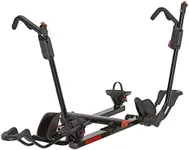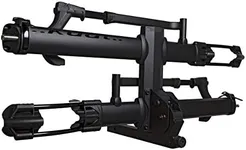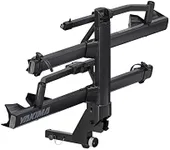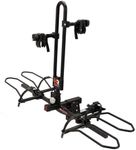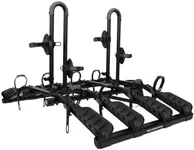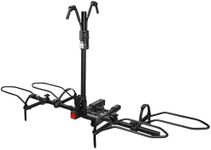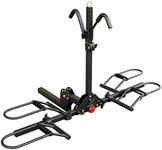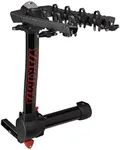Buying Guide for the Best Hitch Mount Bike Racks
Choosing a hitch-mount bike rack is all about finding the right balance between convenience, security, and compatibility with your vehicle and bikes. These racks attach to the hitch receiver at the back of your car, making them easy to load and unload. Before you buy, think about how many bikes you need to carry, the types of bikes you own, and how often you’ll use the rack. Also, consider how much space you have for storage when the rack isn’t in use. By understanding the key features, you can pick a rack that fits your lifestyle and keeps your bikes safe on the road.Hitch Receiver SizeThe hitch receiver size refers to the opening on your vehicle’s hitch where the rack will be inserted, usually measured in inches (commonly 1.25" or 2"). This is important because the rack must match your vehicle’s hitch size to fit securely. Smaller 1.25" receivers are often found on cars and smaller SUVs, while 2" receivers are more common on trucks and larger SUVs. Check your vehicle’s hitch size before shopping, and choose a rack that matches. If you plan to use the rack on multiple vehicles, make sure it’s compatible with all of them.
Bike CapacityBike capacity tells you how many bikes the rack can hold at once. Racks typically range from carrying 2 to 5 bikes. If you usually ride solo or with one other person, a 2-bike rack is enough. For families or group rides, look for racks that hold more bikes. Remember, the more bikes a rack holds, the larger and heavier it will be, so only choose a higher capacity if you really need it.
Rack Type (Platform vs. Hanging)There are two main types of hitch-mount racks: platform and hanging. Platform racks support bikes by their wheels, making them stable and easy to load, especially for heavier or oddly-shaped bikes. Hanging racks suspend bikes by their frames, which can be lighter and less expensive, but may not work well with some bike frames (like step-through or kids’ bikes). If you have a variety of bike styles or want the easiest loading, a platform rack is a good choice. If you want something lighter and simpler, a hanging rack might suit you.
Bike Attachment MethodThis refers to how the rack holds your bikes in place. Some racks secure bikes by the frame, while others use wheel clamps or straps. Frame-holding racks are versatile but can scratch paint or not fit unusual frames. Wheel-holding racks are gentler on the bike and work well for carbon frames or bikes with unique shapes. Think about your bikes’ frame styles and materials when choosing the attachment method.
Tilting and Folding FeaturesMany hitch racks can tilt away from your vehicle, allowing you to open the trunk or hatch without removing the bikes. Some also fold up when not in use, saving space. These features add convenience, especially if you need frequent access to your trunk or have limited storage space. If you often need to get into your vehicle’s rear area, look for a rack with a tilting function.
Security FeaturesSecurity features include locks for the bikes and the rack itself. Some racks come with built-in locks, while others require you to buy them separately. Locks help prevent theft when you leave your bikes unattended. If you plan to leave your bikes on the rack while parked, prioritize racks with strong security features.
Weight CapacityWeight capacity is the maximum total weight the rack can safely carry, usually listed per bike and for the whole rack. This is important if you have heavy bikes like e-bikes or mountain bikes. Check the weight of your bikes and make sure the rack can handle them. If you have lightweight road bikes, most racks will work, but for heavier bikes, look for higher weight limits.

